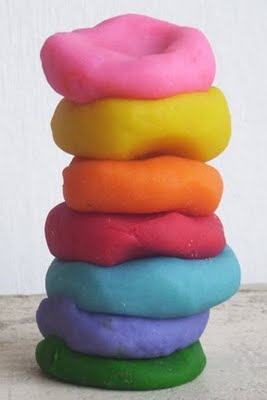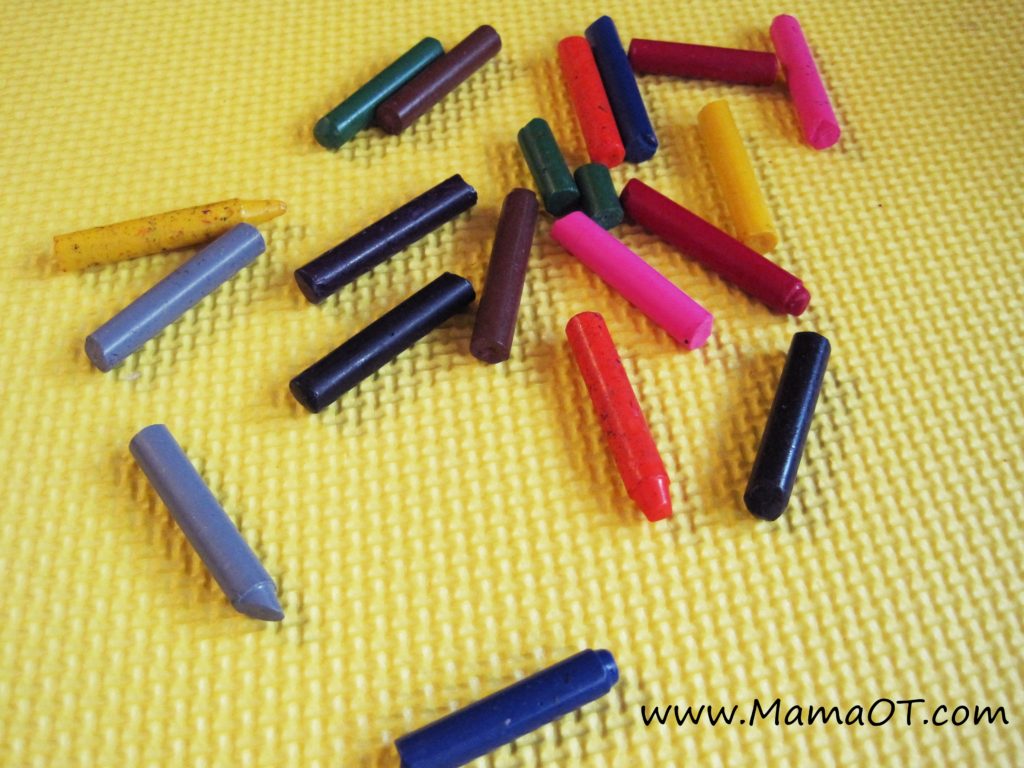Thursday, 22 October 2015
Friday, 16 October 2015
Don’t throw out your broken crayons: Use short crayons to promote correct grasp!
Sound familiar?
I know, you hate it when kids break stuff. It means toys have been ruined and money wasted.
But, thank goodness, it’s not true when it comes to crayons! They are actually better when they’re broken.
Here’s why.
Kids develop the ability to grasp and use a writing utensil in a fairly predictable progression.
- 1 to 1/2 years old: Kids use a “cylindrical grasp”, also called a “fisted grasp”.It looks just like it sounds — they hold the crayon with their entire fist, pinky side down toward the paper.
- 2 to 3 years old: Kids still use all 5 fingers but they change their hand position so their index finger is pointing down toward the tip of the crayon. This is referred to as a “digital grasp” or “digital pronate” (because of the pronated position of the forearm) and marks a significant transition in grasping and fine motor abilities!
- 3 1/2 to 4 years old: Kids begin to hold the crayon with increased dexterity as they transition to holding the crayon with only 4 fingers in a “modified tripod grasp”. This grasp mimics the mature tripod grasp but incorporates additional fingers. Most kids this age have a “static” grasp. This means the movements are primarily coming from the shoulder while the wrist and fingers remain in one position and move together as a unit. This is why kids this age do best with large coloring surfaces and are not yet able to truly color within the lines.
- 4 1/2 to 7 years old: Kids transition into holding the pencil with a more efficient and mature “tripod grasp”. This means they pinch the pencil with the thumb and index finger while resting it on the knuckle of the middle finger. Ideally, the pencil is laying back on the web space of the hand (that fleshy part between the thumb and index finger). A variation of the tripod that is also considered efficient and mature is the “quadrupod grasp”, which is essentially a tripod grasp but with an extra finger pinching the pencil (thumb, index, and middle finger pinch the pencil while resting it on the knuckle of the ring finger). Kids this age transition into using a “dynamic” grasp as they are now able to move the pencil with their finger and wrist movements rather than initiating movement from the shoulder, which allows for increased precision and control while writing, coloring, and drawing.
Sometimes, however, preschool-aged kids will get “stuck” in the fisted or digital pronate grasp and have a hard time transitioning into a more mature grasp.
The solution?
Give them a crayon that’s been broken in half.
This naturally encourages them to “pinch” the crayon between their thumb and index finger, moving them into a more mature and skilled grasp pattern. The reason is simple — it’s hard to use a cylindrical or digital pronate grasp on a short crayon.
Don’t believe me? Try it for yourself.
I actually encourage parents and teachers of young kids to break crayons in half in order to promote more mature grasp patterns as they develop their fine motor skills (be sure to remove the paper, though). And, as an added bonus, it gives you twice as many crayons so there are more to go around!
So the next time you feel the urge to go out and buy more crayons because the ones you have at home are broken, think again! Those broken, washed up crayons are just waiting to be used to help your little ones with the development of their fine motor skills.

Thursday, 15 October 2015
Magical, powerful playdough!

With playdough we do a lot of fun things! - Squishing, rolling, sculpting, molding . . . young children love to play with playdough. Add somefun things from around the home and playdough play becomes a powerful way to support your child’s learning.
This simple tool lets children use their imaginations and strengthen the small muscles in their fingers—the same muscles they will need and use to hold a pencil and write.
Using playdough with you, a friend, or siblings supports your child’s social skills such as sharing, taking turns, and enjoying being with other people. Playdough also encourages children’s language and literacy, science, and math skills—all at the same time!
More information at :http://families.naeyc.org/learning-and-development/music-math-more/playdough-power




Wednesday, 14 October 2015
Tuesday, 13 October 2015
Elmo 1234 - Number 1 - Elmo 123 count with me, Sesame Street Elmo count ...
At school we have just started learning about the number 1! Do you like the number 1? Let's jump 1! We have one nose and one mouth! We love the number 1!!

Wednesday, 7 October 2015
Math in kindergarten
Kindergarten is the foundation for children's development in every skill and therefore it is important for them to grasp general learning concepts from this early age, so that they can have a happy learning experience throughout their lives.
At this age children learn with a lot of repetition, so it is of great importance that at home, you continue to repeat what we have done at school.
The shape of this month is the CIRCLE and the number of this month is the NUMBER 1.
I will be posting different video clips that I am showing the children at school as an introduction to each activity we will be doing.
Happy viewing!
At this age children learn with a lot of repetition, so it is of great importance that at home, you continue to repeat what we have done at school.
The shape of this month is the CIRCLE and the number of this month is the NUMBER 1.
I will be posting different video clips that I am showing the children at school as an introduction to each activity we will be doing.
Happy viewing!

Learn Shape CIRCLE | Teach Babies & Toddlers Shapes in English | Kids Nu...
In the classroom we are going to start learning about circles. Do you see any circles around you? Draw circles with your finger in the air. Find circles at home. We love circles!

Tuesday, 6 October 2015
Monday, 5 October 2015
Are you a girl or a boy?
This is an activity to do so that the children are able to learn if they are male or female. Simply Print and colour.
Let them talk about themselves and please discuss with them that both girls and boys like pink and blue colours, that both like to play with cars or dolls, that both can have long or short hair and most of all that both girls and boys should be treated equally. It is very easy to fall into the stereotype trap of gender roles. It is important that what we do at school, you continue to talk about at home. We are all different, but we are all beautiful and we are all equal! Everyone can choose what he or she wants to be, do or look like. If we teach our kids how to love and respect everyone and to treat everyone how we want to be treated from this young age, they will grow up to be loving and respecting adults. Remember children learn from the example we lead and not from what we tell them to do!
Let them talk about themselves and please discuss with them that both girls and boys like pink and blue colours, that both like to play with cars or dolls, that both can have long or short hair and most of all that both girls and boys should be treated equally. It is very easy to fall into the stereotype trap of gender roles. It is important that what we do at school, you continue to talk about at home. We are all different, but we are all beautiful and we are all equal! Everyone can choose what he or she wants to be, do or look like. If we teach our kids how to love and respect everyone and to treat everyone how we want to be treated from this young age, they will grow up to be loving and respecting adults. Remember children learn from the example we lead and not from what we tell them to do!

Friday, 2 October 2015
Activity to do at home after first days at school
Dear parents this is a sweet activity you can do with your child at home. Just print out this page and spend a few minutes discussing with them what they did at school.
Ask: What is the name of your teacher?
What toys are there in your classroom?
What did you colour with the teacher?
What did you paint with the teacher?
What are the names of your new friends?
Then let them draw however they like in the boxes on this picture of a school and then hang it up at home.
Enjoy it!
Just remember that these little moments you spend with your children will build a positive attitude towards school that will last a lifetime!
Ask: What is the name of your teacher?
What toys are there in your classroom?
What did you colour with the teacher?
What did you paint with the teacher?
What are the names of your new friends?
Then let them draw however they like in the boxes on this picture of a school and then hang it up at home.
Enjoy it!
Just remember that these little moments you spend with your children will build a positive attitude towards school that will last a lifetime!

Lovely first two days
We had a lovely time these first two days at school! Please check our Photo gallery for a glimpse of what we were doing in our classroom. We are growing up so fast and we are enjoying every minute of it. Please have some patience if we cry a bit, we are still adjusting to a new very important phase of our lives. We love you so much.
Signed: Your children at K1.6

Subscribe to:
Comments (Atom)









